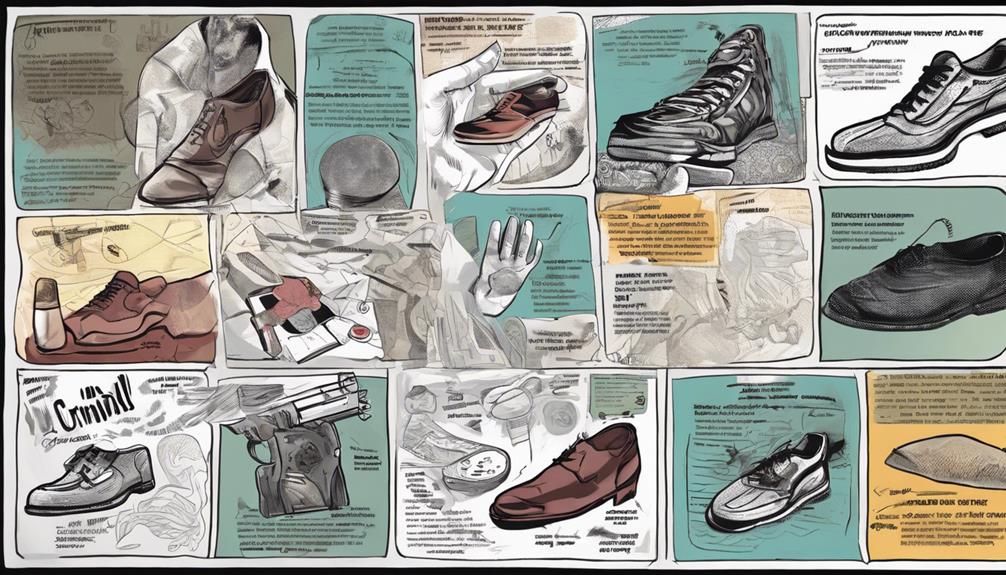Finance and Technology
Breaking Down the Cost of Living in Chicago: Can You Afford It?
Taking a closer look at Chicago's cost of living reveals surprising expenses and opportunities that will make you rethink your decision to move.

As you consider making Chicago your home, it's important to understand the city's diverse cost of living. Housing costs are steep, with a median home price of $291,200 and average 1-bedroom apartment rent of $1,336. Transportation expenses, like a $75 monthly transit pass, add up too. Healthcare, food, and utility bills also contribute to the overall cost. On the bright side, Chicago offers a strong job market and diverse entertainment options. To get a thorough picture of the city's expenses and opportunities, you'll want to explore each of these factors in more detail, which can help you determine whether Chicago is the right fit for you.
Key Takeaways
- The median home cost in Chicago is $291,200, with a housing appreciation rate of 19.66% and average apartment rent of $1,336 for a 1-bedroom.
- Transportation expenses for a single adult average $5,356 annually, with a monthly local transit pass costing $75 and a single L train trip costing $2.50.
- Healthcare costs in Chicago include an average doctor's visit cost of $170, an optometrist visit cost of $109.81, and a Lipitor medication price of $420.30.
- The average monthly grocery cost for a single adult in Chicago is $300, with a sales tax of 10.25% plus a 0.5% restaurant tax, and average utility costs of $214 per month.
- A living wage in Chicago is around $18.72 per hour, with a median household income of $65,781 and diverse job opportunities in various industries.
Housing Costs in Chicago
When searching for a place to call home in Chicago, you'll likely encounter a median home cost of $291,200, with an appreciation rate of 19.66%, making it essential to factor these housing costs into your budget. The city's housing costs have increased noticeably, with apartment rents rising by 51.30%.
Renting isn't cheap either, with a 1-bedroom apartment averaging $1,336 and a 2-bedroom costing around $1,450. To afford a median-priced 1-bedroom apartment, you'll need an annual income of $53,440. If you're considering buying, be prepared for a property tax rate of 2.27%. On a $217,500 home, that's $4,942 in property taxes.
Affordable housing options are limited, and the appreciation rate highlights the urgency to find a place that fits your budget. As you weigh your housing options, keep in mind that Chicago's high housing costs will significantly impact your overall cost of living.
Transportation Expenses

As you navigate the Windy City, your wallet will feel the impact of transportation expenses, which can add up quickly, with the average annual cost for a single adult in Chicago totaling $5,356.
This substantial amount can be broken down into various transportation costs, including public transit, which is a convenient option for many Chicagoans. A monthly local transit pass, for instance, will set you back $75.
If you need to travel from the suburbs to Chicago, Metra Rail is a reliable option. For shorter trips, the L train is a popular choice, with a single one-way trip costing $2.50.
These costs can add up, especially for families: transportation expenses for a family of three in Chicago amount to $11,780 per year.
As a single adult, it's crucial to factor these costs into your budget to make sure you can afford the lifestyle you want in Chicago. By understanding the transportation expenses involved, you can make informed decisions about how to manage your finances and get around the city efficiently.
Healthcare in Chicago

Navigating the healthcare system in Chicago requires understanding the costs associated with medical care and the options available to you. From doctor's visits to prescription medications, having a clear picture of what to expect financially is crucial.
In this section, we'll break down the medical costs and explore the health insurance options that can help you manage these expenses.
Medical Costs Analysis
You'll likely pay around $170.00 for a doctor's visit in Chicago, a cost that's relatively in line with other major cities in the United States. This is just one aspect of medical costs in Chicago, which can add up quickly.
If you need to see an optometrist, you'll pay around $109.81 for a visit. If you're prescribed Lipitor medication, be prepared to pay $420.30. And, a dentist visit will set you back around $122.00.
Fortunately, healthcare services in Chicago are accessible with various providers and clinics. While these costs might seem steep, they're an important part of maintaining your health. It's essential to factor these expenses into your budget to ensure you can afford the care you need.
Health Insurance Options
When it comes to managing healthcare expenses in Chicago, having a suitable health insurance plan can greatly reduce your out-of-pocket costs. You'll find that healthcare services are readily available in Chicago, with numerous providers and clinics scattered throughout the city.
While prescription medication prices in Chicago are comparable to national averages, an affordable health insurance plan can help mitigate these expenses. Fortunately, Chicago offers a range of affordable plans to help you manage your healthcare costs.
Keep in mind that Chicago's average sales tax and dining taxes will also affect your overall cost of living, including healthcare expenses. However, with the right health insurance plan, you can enjoy quality medical services without breaking the bank.
Food and Grocery Prices

As you navigate the cost of living in Chicago, you'll want to take into account the expenses associated with food and groceries.
You'll find that eating out can add up quickly, with a meal at a budget-friendly restaurant costing around $15.
Grocery shopping will set you back around $300 per month for a single adult.
From meal delivery options to grocery store prices, understanding these costs will help you plan your budget effectively.
Eating Out Expenses
Your eating out expenses in Chicago will likely add up quickly, especially with the city's high sales tax and additional restaurant tax. When dining out in Chicago, you'll need to take into account these extra costs when budgeting for food expenses.
Here are some key facts to bear in mind:
- A meal at a budget-friendly restaurant in Chicago averages around $15
- A three-course meal at a mid-range restaurant costs approximately $72
- Chicago has a sales tax of 10.25% with an additional 0.5% restaurant tax
- Dining out expenses vary, so planning ahead is crucial
- You can expect to pay around $15-$30 per meal at a casual restaurant, depending on the location and type of cuisine
Grocery Store Prices
How much are you willing to spend on groceries in Chicago, where a loaf of bread costs $3.79 and a dozen eggs will set you back $4.02?
When it comes to grocery store prices, Chicagoans can expect to pay a premium for their daily essentials. The average cost of a loaf of bread in Chicago is $3.79, while a dozen eggs will cost you around $4.02.
If you're looking to grab a gallon of milk, be prepared to shell out around $3.92.
If you're in the mood for a quick dinner, a 12-inch pizza from Pizza Hut will set you back $4.89. And if you're craving a Quarter-Pounder with cheese from McDonald's, expect to pay around $13.39.
These prices may seem steep, but they're the reality of grocery store prices in Chicago. Understanding the cost of groceries is essential to budgeting your expenses and making the most of your hard-earned cash. By knowing what to expect, you can plan your meals, shop smart, and make the most of your grocery budget.
Meal Delivery Options
You'll find a range of meal delivery options in Chicago, from popular services like Grubhub, Uber Eats, and DoorDash, which can bring everything from local favorites to international dishes right to your doorstep. With the convenience of meal delivery, you can enjoy diverse cuisines without stepping foot outside. But what's the cost of this convenience?
Here are some key things to know about meal delivery in Chicago:
- Average cost of a meal delivery ranges from $10 to $30, depending on the restaurant and distance.
- Grocery delivery services like Instacart and Peapod are convenient options for stocking up on essentials.
- Meal delivery apps offer discounts, promotions, and loyalty programs to make dining in Chicago more affordable.
- You can enjoy local favorites and international dishes, expanding your culinary horizons.
- Meal delivery services operate in various Chicago neighborhoods, making it easy to find options near you.
When considering meal delivery in Chicago, weigh the cost against the convenience and flexibility it offers. With various services and options available, you can find a meal delivery solution that fits your budget and lifestyle.
Utility Bills and Services

As you settle into your 915 sq ft apartment in Chicago, you can expect to pay around $150 per month in average utility costs. This is relatively important, given that Chicago's utility costs are 7% lower than the national average. Your utility bills will cover essential services like electricity, water, gas, and trash removal.
When budgeting for your cost of living in Chicago, it's important to take into account these utility expenses.
In addition to these basic services, you'll also need to factor in internet service, which typically costs around $64 per month in Chicago. This will bring your total utility expenses to around $214 per month.
While this may seem like a significant expense, it's important to remember that these costs are relatively low compared to other major cities. By understanding these average utility costs, you can better plan your Chicago cost of living and guarantee a comfortable lifestyle in this vibrant city.
Entertainment and Leisure

After covering the necessary expenses like utility bills, it's time to focus on the fun stuff – enjoying Chicago's vibrant entertainment and leisure activities, which can quickly add up if not budgeted for. As you explore the city, you'll find a wide range of options to suit your interests and budget.
Here are some costs to take into account:
- A movie ticket averages $18.94, making it essential to budget for entertainment expenses.
- Enjoying a yoga class will set you back around $26.67, adding to your leisure costs in the city.
- Indulging in a 6-pack of Heineken beer will cost you approximately $9.91, a popular choice for social gatherings or relaxation.
- Chicago offers a variety of entertainment options, from theaters to sports events, catering to different interests and budgets.
- With an average of 0.51 bars per 1,000 people, Chicago provides ample options for socializing and unwinding after work or on weekends.
Remember to factor these costs into your budget to take full advantage of Chicago's entertainment and leisure activities without breaking the bank.
Taxes and Insurance

Chicago's taxes and insurance costs can be a substantial burden, with property taxes alone accounting for a significant portion of your expenses. As a homeowner, you'll need to take into account the 2.27% property tax rate, which translates to $4,942 in annual taxes on a $217,500 home.
The effective property tax rate is 2.23%, which impacts homeownership costs in Chicago. Additionally, you'll need to factor in sales tax, which stands at 10.25%, along with a 0.5% restaurant tax. These tax rates contribute greatly to the cost of living in Chicago, making it important to understand them for budgeting and financial planning.
When planning your expenses, remember that property and sales taxes will take a chunk out of your income. It's essential to factor these costs into your financial planning to avoid financial strain.
Job Market and Salary

With a median household income of $65,781, you'll need to earn a decent salary to afford the cost of living in Chicago, especially considering the city's high taxes and insurance costs. To thrive in this vibrant city, you'll want to secure a job that pays a living wage, which is around $18.72 per hour for a single individual.
Chicago's job market attracts newcomers with opportunities in diverse industries like:
- Manufacturing
- Transportation
- IT
- Health services
You'll find major companies like McDonald's, Boeing, United Continental, Mondelez International, and Conagra Brands, offering opportunities for career growth.
As a college student, you can utilize resources like Apartment List to explore the best places to live in Illinois and find apartments that fit your budget.
With a strong job market and opportunities for career advancement, Chicago is an attractive destination for those seeking a thriving career.
Additional Expenses to Consider

You'll need to factor in several additional expenses when budgeting for life in Chicago, including healthcare costs, transportation fees, and miscellaneous goods.
These expenses can add up quickly, so it's crucial to take them into account when planning your financial strategy for Chicago living. When it comes to healthcare costs, don't forget to factor in expenses like doctor's visits, prescription medications, and dental care. These costs can be significant, especially if you have ongoing health issues or require regular check-ups.
Moreover, you'll need to budget for transportation fees, including gas prices, public transit fees, and potential car maintenance. These expenses can vary depending on your lifestyle and transportation choices.
Additionally, you'll need to account for miscellaneous goods like groceries, clothing, and personal care items. These expenses might seem minor, but they can impact your overall cost of living in Chicago.
Frequently Asked Questions
What Is the Salary to Afford Living in Chicago?
To afford living in Chicago, you'll need an annual income of at least $53,440 for a median-priced 1-bedroom apartment, but ideally, you should earn around $65,781, the city's median household income, to live comfortably.
Is $75,000 Enough to Live in Chicago?
Like a puzzle piece fitting snugly into place, your $75,000 income in Chicago clicks into a comfortable living situation, allowing you to afford a 1-bedroom apartment, transportation, and more, with smart budgeting and cost-saving strategies.
Is $90,000 a Good Salary in Chicago?
You're earning $90,000 in Chicago – that's a great salary! You'll comfortably afford a median-priced 1-bedroom apartment, enjoy dining out, and still save for the future, making it a very good salary in the city.
Is 60K a Good Salary in Chicago for a Single Person?
You're exploring the Chicago streets with a $60,000 salary, and it's like having a roadmap to a comfortable lifestyle. You can afford a decent apartment, public transportation, and enjoy the city's perks, as long as you budget wisely.
Conclusion
As you weigh the pros and cons of calling Chicago home, keep in mind that the Windy City's costs add up quickly. From housing to healthcare, every expense counts.
While the city's vibrant culture and opportunities are enticing, it's essential to take into account the financial realities. So, can you afford to live in Chicago? The answer lies in your own budget and priorities.
As the city's motto goes, 'Urbs in Horto' – a city in a garden – but only if you're willing to tend to your finances carefully.
Finance and Technology
Hauling Basics: What Is a Plate Trailer and How Is It Used?
Intrigued by plate trailers? Discover their unique features and versatile applications for efficient cargo transport.

Plate trailers, known for their efficient use of interior space, offer benefits like e-track for cargo securement and compliance with food safety regulations. They cater to industries needing ample space and strength for diverse cargo. Commonly used for heavy loads, automotive freight, and paper companies, plate trailers exceed standard width for accommodating larger items. Equipped with logistic posts, they guarantee stable transporting of various goods. Understanding 102-plated trailers is key, as they provide extra room for wider loads. To use a plate trailer effectively, secure containers properly, maintain regularly, and consider specific width requirements. Further insights on plate trailer utilization are available within the research.
Key Takeaways
- Plate trailers have a smooth interior resembling a plate for efficient cargo storage.
- Equipped with e-track for cargo securement, plate trailers are favored by food-grade shippers.
- Plate trailers provide increased width, ideal for heavy, non-palletized loads, and wider items.
- Commonly used for heavy loads, automotive freight, and paper companies, plate trailers offer structural strength.
- Regular maintenance, securement of containers, and specialized container transport are key considerations for plate trailers.
Plate Trailer Vs. Sheet and Post Trailer
When comparing plate trailers to sheet and post trailers, the key differences lie in their construction and practical advantages.
Plate trailers have a smooth interior resembling a plate, which allows for more interior space compared to their exterior width. This feature is beneficial for maximizing cargo capacity while adhering to width regulations. On the other hand, sheet and post trailers utilize wooden posts and sheets for their walls, providing added strength and durability.
Although plate trailers may cheat the 102-inch width rule slightly, their thin but durable walls enable more efficient cargo storage.
The inside width of plate trailers is advantageous for various industries, especially in food-grade trucking where cleanliness and ample space are important. In contrast, sheet and post trailers, being more traditional in construction, may lack the stability and internal space that plate trailers offer.
To conclude, plate trailers excel in providing a balance of strength, durability, and increased interior width for efficient cargo transportation.
Benefits of Plate Trailers

Plate trailers offer a range of benefits that make them a preferred choice for transporting various types of cargo efficiently and securely. These trailers come equipped with e-track in the metal walls, guaranteeing securement of cargo at regular intervals. This feature is particularly advantageous for keeping different types of loads in place during transit, minimizing the risk of shifting or damage.
Plate trailers are also highly favored by food-grade shippers due to the absence of wood in the walls. This feature not only guarantees cleanliness but also helps in complying with strict food safety regulations. With an inside width typically measuring 101 inches, plate trailers provide ample internal space for maximizing payload capacity, making them ideal for accommodating a wide range of cargo sizes.
Additionally, their structural strength makes plate trailers suitable for heavy loads and non-palletized shipments, offering versatility and reliability in transporting goods of varying sizes and weights.
Common Uses of Plate Trailers

Commonly utilized in various industries, plate trailers serve a multitude of purposes for transporting different types of cargo efficiently and securely. Companies that ship heavy loads, such as automotive freight and paper companies, often rely on plate trailers due to their structural design, which is ideal for carrying max weight loads and non-palletized shipments.
The inside of the trailer is equipped with logistic posts and securement straps every 4 feet, guaranteeing load stability and safety during transit. Plate trailers provide slightly more width than the standard 102-inch rule, allowing for more internal space for cargo storage. This extra width can be beneficial when transporting wider items that may not fit within regular trailers.
For instance, plywood sheets that need the additional width for secure transportation are commonly transported using plate trailers. It's crucial to take into account the specific width requirements when booking wider loads to ensure they fit comfortably inside the trailer.
Understanding 102-Plated Trailers

An insight into the structural features of 102-plated trailers reveals their unique advantages for transporting wider loads efficiently. These trailers boast an inside width of approximately 101.25 inches, offering more cargo space compared to standard trailers.
To enhance stability during transportation, 102-plated trailers are equipped with logistic posts for securement every 4 feet. Industries such as automotive freight and paper companies favor these trailers for their ability to carry heavy loads while maximizing payload capacity.
The 102-inch width of these plate trailers slightly exceeds the standard, providing extra room for accommodating wider loads. For loads wider than 99 inches, it's important to verify the interior width to make sure proper fitting inside 102-plated trailers.
Tips for Using a Plate Trailer

When using a plate trailer, it is important to ensure proper securing of containers, adherence to weight restrictions, and regular maintenance to optimize efficiency and safety.
Plate trailers lack sides and roofs, making them lightweight and ideal for container transport in intermodal shipping. To guarantee safety, always double-check that the containers are securely locked in place using the twist locks provided. Additionally, be mindful of weight restrictions to prevent overloading, which can lead to accidents and damage.
Regular maintenance is key for plate trailers. Inspect the trailer inside and out, checking for any signs of wear and tear that could compromise its structural integrity. Utility trailers like plate trailers require a special license to operate, so make sure you have the necessary qualifications before use.
Remember that plate trailers are best suited for specialized container transport and may not be as versatile for general cargo hauling. Always stay vigilant, especially when maneuvering in tight spaces or adverse weather conditions. Keep these tips in mind to ensure a smooth and safe hauling experience.
Frequently Asked Questions
What Is a Plate Trailer?
A plate trailer is a type of semi-trailer designed for carrying shipping containers. It has no sides or roof, measures 40 or 45 feet in length, and requires a chassis for transportation.
What Type of Trailer Pays the Most?
When hauling heavy loads, plate trailers pay the most. They are ideal for non-palletized shipments, maximizing cargo space, and securely transporting large, heavy items. Specificity in load requirements exceeding 99 inches is essential for successful transportation.
What Is the Most Commonly Used Trailer?
The most commonly used trailer is the dry van. It's versatile and can haul a variety of goods. Plate trailers are specialized for container transport. Understanding each trailer's purpose is essential for efficient shipping operations.
What Are Different Trailers Called?
You know what people call different trailers? Plate trailers go by names like Duraplate, Ultraplate, and Zplate. They're unique with smooth walls for more space, logistic posts every 4 feet, popular for autos and papers.
Conclusion
To summarize, a plate trailer is like the sturdy backbone of the hauling world, providing strength and reliability for transporting heavy loads. Its flat, solid surface and versatile design make it a valuable asset for various industries, from construction to agriculture.
So, next time you see a plate trailer on the road, remember that it's not just a piece of metal – it's a crucial tool for getting the job done efficiently and effectively.
Finance and Technology
Professional Email Etiquette: What Is 'Via Email' and How to Use It
Kickstart your professional email etiquette journey by mastering the essential concept of 'Via Email' – a game-changer for effective communication.

Understanding 'Via Email' is crucial for professional email etiquette. It clarifies the communication channel, boosting efficiency and maintaining a professional tone. Incorporate it in the subject line to signal the primary mode of communication clearly and in the body for transparency. Use it judiciously to enhance professionalism, avoiding overemphasis. Best practices include strategic placement for clarity and effectiveness. Position 'Via Email' at the end of the subject line to indicate the mode of delivery. Inside the email body, it offers extra clarification when necessary. Mastering this simple technique can greatly improve your email communications.
Key Takeaways
- Specifies email as primary communication channel for clarity.
- Enhances professionalism in email exchanges.
- Use strategically in subject line or email body.
- Avoid redundancy, place 'Via Email' judiciously.
- Provides clear communication setting and boundaries.
Importance of 'Via Email'
Understanding the importance of 'Via Email' is crucial for effective communication in professional environments. When you specify 'Via Email' in your correspondence, you're clearly indicating that email is the chosen channel for interaction. This not only sets the expectation for the recipient but also helps in streamlining communication.
By using 'Via Email,' you're ensuring clarity in your message and making it easier for the recipient to understand the preferred method of response. This simple addition to your emails can greatly enhance efficiency in communication by eliminating any ambiguity surrounding the communication channel. It also signals to the recipient that you value clear and direct interactions, promoting a professional tone in your correspondence.
Hence, always remember to include 'Via Email' when initiating professional communication to set the right expectations and facilitate smoother interactions.
Clarifying Communication Channels

When specifying 'Via Email' in your professional communication, you're effectively clarifying the chosen channel for interaction. This clarification of the communication channel helps in the following ways:
- Specify Preferred Mode of Contact: By using 'Via Email,' you indicate your preferred method of communication for a specific message within professional email settings.
- Enhance Efficiency: Clarifying the communication channel through 'Via Email' ensures that recipients understand how information is being shared, enhancing the effectiveness of the communication process.
- Provide Clear Communication Settings: It helps in setting clear communication settings by indicating the primary means of contact, ensuring that the message is appropriately received and understood.
In professional email etiquette, the use of 'Via Email' is important for effective communication, as it streamlines the method of information sharing and avoids any ambiguity regarding the preferred mode of contact for a specific message.
Using 'Via Email' in Subject Line

You can effectively signal the mode of communication by including 'Via Email' in the subject line of your professional emails. This simple addition helps recipients identify the primary communication channel and distinguishes email exchanges from other forms of communication.
In professional settings, specifying 'via email' in the subject line enhances clarity and guarantees that email is recognized as the mode of communication. By using this practice, you establish clear boundaries and set expectations for the recipient regarding the primary communication medium.
Including 'via email' in the subject line is an essential aspect of email etiquette. It's a common practice that aids in maintaining professionalism and clarity in your email communications.
When crafting your subject line, don't overlook the importance of specifying the communication channel to streamline your interactions and promote effective communication in professional settings.
Incorporating 'Via Email' in Body

When composing emails, remember to incorporate 'Via Email' in the body to specify the method of communication. This simple addition clarifies how information was shared or tasks were executed.
Enhance transparency and accountability by utilizing 'Via Email' to document your email interactions.
Proper 'Via Email' Usage
Incorporating 'Via Email' within the body of your email guarantees clear communication regarding the chosen method of correspondence. To secure proper usage and enhance clarity in email communication, follow these guidelines:
- Specify Communication Channel: Use 'Via Email' to clearly indicate that the message is being transmitted through email, distinguishing it from other communication methods.
- Provide Transparency: By including 'Via Email,' you offer transparency to the recipient about the primary mode of communication, fostering understanding and alignment on the expected channel.
- Enhance Clarity: The use of 'Via Email' helps convey information effectively, reducing any ambiguity about the communication medium and ensuring a professional tone in your message.
Etiquette Tips for Emails
To effectively uphold professionalism in email communication, guarantee the proper use of 'Via Email' to indicate the mode of correspondence. Email etiquette plays an essential role in maintaining a professional image and fostering effective communication.
When including 'via email' in the body of your message, you enhance transparency by clearly stating that the communication is electronic. This simple addition adds a touch of importance to your correspondence, signaling to the recipient the channel through which the message is being relayed.
Using 'via email' promotes clarity by eliminating any ambiguity about the method of communication. It sets clear expectations for the recipient, ensuring they understand that the message is being sent through the electronic medium.
When to Use 'Via Email'

When deciding when to use 'Via Email' in your email communication, consider situations where you need to indicate the mode of transmission clearly.
Proper usage examples could include forwarding important information or replying to a chain of emails where clarity is key.
Understanding the etiquette and common mistakes associated with using 'Via Email' can enhance professionalism in your email correspondence.
Proper Usage Examples
You should use 'via email' judiciously to clearly indicate the method of communication in your professional correspondence.
Include 'via email' when specifying how information was sent or received, such as, 'The meeting agenda was shared via email.'
Avoid redundancy by using 'via email' only when necessary to prevent overemphasizing the mode of communication.
'Via email' adds clarity to communication regarding the method of transmission, ensuring that all parties understand how the information was exchanged.
Etiquette Tips
Consider incorporating the phrase 'via email' in your professional correspondence to clearly denote the method of communication and enhance clarity in your interactions.
When practicing proper email etiquette, remember to utilize 'via email' in subject lines to specify the mode of communication.
Avoid using emojis excessively, as they may come across as unprofessional.
Make sure your email signature contains all necessary information for easy identification.
Respond promptly to emails to demonstrate professionalism and respect for others' time.
When forwarding emails, including 'via email' can help recipients understand the context.
It's essential to Bcc all emails when necessary to maintain confidentiality.
Stick to a standard font size and format to ensure readability.
Communicate clearly in your emails, avoiding jargon and using a casual language only when appropriate.
Common Mistakes
To avoid common mistakes with the usage of 'via email,' make sure that you don't overuse this phrase in your email communication. Here are some tips to help you navigate the proper use of 'via email':
- Avoid Using 'Via Email' in the Subject Line: Reserve the subject line for essential information. Including 'via email' here can clutter the subject and make it less impactful.
- Use 'Via Email' Sparingly in the Body: While it's acceptable to mention 'via email' once in the body of a formal email, avoid using it repeatedly. This can distract from the message you want to convey.
- Consider the Recipient's Perspective: Think about how the recipient reads your email. If 'via email' doesn't add value or clarity to the message, it may be best to omit it. Maintaining a clean and professional email is key in a business setting.
Best Practices for 'Via Email

When incorporating 'Via Email' in your communication, make sure it's placed strategically for clarity and effectiveness. Best practices for including 'Via Email' in your business emails involve using it either in the body of the email or as part of the subject line.
Adding 'Via Email' helps recipients identify the source and channel of the communication, enhancing overall clarity in professional communication. In the subject line, you can position 'Via Email' at the end to indicate the mode of delivery right from the start.
When placed in the body of the email, it can be useful if the email's purpose or content might be misunderstood or needs extra clarification. Remember to use 'Via Email' appropriately to avoid redundancy and to specify that the message was sent through electronic mail.
Frequently Asked Questions
When Communicating via Email, You Should?
When communicating via email, you should be clear, concise, and professional. Use 'via email' in your signature to indicate the communication channel. Avoid excessive use but offer alternative contact methods if needed for effective communication.
What Are the Five Rules of Email Etiquette?
When emailing, always remember the five rules of email etiquette. Be concise, use a professional tone, mind your grammar, respond promptly, and respect others' time. Following these guidelines guarantees effective and respectful communication.
What Is Professional Email Etiquette?
Professional email etiquette involves clear and respectful interactions in email communication. It establishes professionalism, enhances relationships, and boosts career opportunities. Understanding and applying these principles is essential for successful workplace communication and career advancement.
How to Use Email Professionally?
When using email professionally, make clear and concise communication. Use proper salutations, subject lines, and signatures. Respond promptly, proofread for errors, and avoid using all caps or excessive exclamation points. Maintain professionalism in all aspects of your email correspondence.
Conclusion
To wrap up, using 'Via Email' in professional communication is essential for clarity and efficiency. By clearly indicating the communication channel, you can guarantee that your message reaches the intended recipient in a timely manner.
Remember, when in doubt, always opt for 'Via Email' to streamline your correspondence. Just like a well-oiled machine, clear communication channels help keep everything running smoothly.
Finance and Technology
Criminal Investigation 101: What Is Individual Evidence?
Open the door to the world of criminal investigations with a deep dive into the crucial role of individual evidence in solving cases.

In criminal investigations, individual evidence, like DNA profiles and fingerprints, acts as unique markers essential for identifying suspects and linking them directly to crime scenes or victims. These distinct traits aid investigators in narrowing down suspects and building strong cases by establishing a direct connection to the accused. Understanding individual evidence is vital for solving crimes efficiently and effectively. By recognizing these specific markers, investigators can piece together the puzzle of a case, ultimately leading to successful resolutions. Continuing will uncover further insights into the significance and role of individual evidence in criminal investigations.
Key Takeaways
- Individual evidence includes unique traits like DNA profiles, fingerprints, and handwriting characteristics for identification.
- It directly links a specific individual to a crime scene, aiding in narrowing down suspects.
- Specialized techniques are required to accurately identify distinct markers in individual evidence.
- Meticulous examination of unique characteristics helps establish direct links between suspects and crimes.
- Examples of individual evidence include DNA, fingerprints, handwriting, unique tool marks, and digital evidence.
Definition of Individual Evidence
Individual evidence, in criminal investigation, refers to physical evidence that can be traced back to a single source or person. This type of evidence plays a critical role in linking suspects to crime scenes or victims.
Examples of individual evidence include fingerprints, DNA, and handwriting. Such evidence is unique to a specific individual, making it invaluable in establishing connections within a case.
By analyzing trace evidence left behind at a crime scene, investigators can directly link this physical evidence to a particular person. This direct link helps build a stronger case against a suspect by providing concrete evidence of their involvement.
Essentially, individual evidence serves as a pivotal tool in criminal investigations, offering a clear connection between the evidence found and the person responsible. Understanding and analyzing individual evidence is essential for identifying perpetrators and bringing them to justice.
Characteristics of Individual Evidence

What distinct features set individual evidence apart in criminal investigations? Individual evidence is unique to a specific source, allowing for direct linkage to that particular individual or object. This type of evidence, such as DNA profiles, fingerprints, and handwriting characteristics, plays a pivotal role in establishing connections and identifying suspects in criminal cases. Analyzing individual evidence involves specialized techniques and comparison to known samples for accurate identification.
To better understand the characteristics of individual evidence, let's explore some common types and their significance in scientific evidence:
| Types of Evidence | Description | Importance in Investigations |
|---|---|---|
| DNA Profiles | Unique genetic information of an individual | Essential for precise identification |
| Fingerprints | Distinctive patterns left at a crime scene | Key for linking individuals to locations |
| Handwriting Characteristics | Individual writing traits for analysis | Helpful in determining authorship |
These types of scientific evidence provide crucial insights in criminal investigations, aiding in the process of solving cases and bringing justice to those involved.
Importance in Criminal Investigations

Individual evidence holds immense importance in criminal investigations as it can directly link a specific individual to a crime scene or victim. By providing unique characteristics like fingerprints and DNA, individual evidence plays a vital role in establishing the presence of a particular person in connection to a crime.
This type of evidence is essential for investigators to narrow down suspects, build strong cases, and present concrete links between the accused and the crime in court proceedings.
Evidence Significance Explained
Understanding the significance of evidence in criminal investigations is paramount as it forms the cornerstone of building a strong case against a suspect. Individual evidence plays a critical role in these investigations, especially in linking a specific person or object to a crime scene.
This type of evidence is pivotal and can help identify a particular source, like a specific weapon or tool used in a crime. By analyzing individual evidence such as fingerprints, DNA, or unique markings on objects, investigators can establish a direct connection between a suspect and the crime being investigated.
This direct link is essential in providing concrete evidence that can strengthen the case against the perpetrator. Therefore, the significance of individual evidence can't be overstated in criminal investigations, as it aids in establishing solid connections between suspects, victims, and the scenes of the crimes.
Role in Investigations
The importance of individual evidence becomes evident in criminal investigations due to its pivotal role in establishing direct connections between suspects and the crimes under scrutiny. Crime scene investigators rely on hard evidence such as fingerprints, DNA, fibers, and other unique trace materials to link a specific person or object to a crime scene or victim.
This type of evidence provides vital insights into the involvement or presence of individuals in criminal activities. By analyzing individual evidence, investigators can strengthen a case significantly, as it offers concrete proof of a suspect's association with the crime. Specialized techniques and expertise are required to accurately identify and interpret the distinct markers present in individual evidence.
Through the meticulous examination of these unique characteristics, investigators can establish a direct link between the suspect and the crime, aiding in the successful resolution of criminal cases.
Relevance to Cases
In criminal investigations, the significance of individual evidence is paramount for establishing direct connections between suspects and the crimes in question. This type of evidence, which can include DNA, fingerprints, shoeprints, and unique tool marks, plays an essential role in linking a specific person to a crime scene or victim. By presenting individual evidence collected from the scene, investigators can show a direct correlation between the suspect and the crime committed, making it an important part of the case presented in court.
To further understand the significance of individual evidence, let's look at a comparison table showcasing its importance in criminal investigations:
| Evidence Presented | Importance |
|---|---|
| DNA | Provides unique genetic link |
| Fingerprints | Directly links a person to a scene |
| Shoeprints | Connects a suspect to a specific location |
| Tool Marks | Links a particular tool to the crime |
| Clothing Fibers | Associates a person with the scene |
Examples of Individual Evidence

Individual evidence encompasses specific physical traits that can be traced back to a single source, such as DNA, fingerprints, and unique tool marks.
These examples play an essential role in criminal investigations by helping to pinpoint suspects or objects with precision.
Utilizing individual evidence can greatly bolster the strength of connections established in a case.
Types of Individual Evidence
When identifying types of individual evidence, consider examples such as DNA, fingerprints, handwriting, and unique tool marks. Each of these types plays an essential role in criminal investigations by providing unique identifiers that link a suspect to a crime scene or victim. Here is a breakdown of some common types of individual evidence:
| Type of Individual Evidence | Description |
|---|---|
| DNA | Genetic material unique to each individual, often collected from bodily fluids or hair. |
| Fingerprints | Unique patterns on the fingertips that can be lifted from surfaces at a crime scene. |
| Handwriting | Distinctive way of writing that can be compared to known samples for identification. |
| Unique Tool Marks | Impressions left by tools or objects that are unique to a specific tool, linking it to a crime. |
| Digital Evidence | Information stored electronically that can be used to establish a person's involvement in a crime. |
These types of individual evidence serve as vital pieces in the puzzle of solving criminal cases, providing investigators with concrete links to suspects and aiding in the pursuit of justice.
Significance in Investigations
How does individual evidence greatly impact criminal investigations?
Individual evidence plays a vital role in investigations as it provides specific links between the scene of the crime and potential suspects. This type of evidence must be unique to a particular person or object, such as DNA, fingerprints, handwriting, or tool marks.
By analyzing individual evidence found at the scene of the crime, investigators can narrow down their focus to specific individuals, helping to establish connections and build a strong case in court.
For instance, DNA evidence must be carefully collected and analyzed to match it to a specific individual, providing irrefutable proof of their presence at the crime scene. Similarly, unique tool marks or handwriting can be directly linked to a particular suspect, aiding in their identification and potential prosecution.
Role in Connecting Suspects

Utilizing individual evidence in criminal investigations plays an essential role in directly connecting suspects to specific items or locations at crime scenes. This type of evidence, such as DNA, fingerprints, or tool marks, is used to establish a direct link between a suspect and the crime.
By analyzing these unique characteristics, investigators can determine the involvement of a suspect with a high level of specificity. Types of individual evidence, like DNA profiles or distinct tool marks, provide a strong basis for connecting a suspect to the scene of the crime or the victim. This specificity helps build a compelling case against the suspect, highlighting their direct connection to the criminal activity.
Focusing on individual evidence allows investigators to narrow down their list of suspects and strengthen the connection between the crime and the perpetrator. To conclude, individual evidence serves as an important tool in connecting suspects to specific elements of a crime scene, aiding in the investigative process.
Collection and Preservation Methods

Properly collecting and preserving individual evidence is essential in maintaining its integrity and reliability for criminal investigations. When dealing with physical evidence, follow these steps to guarantee the evidence remains intact and admissible:
- Documentation: Carefully document the location, condition, and any observations related to the individual evidence. Detailed notes help establish the context and significance of the item.
- Packaging and Labeling: Use appropriate containers and packaging materials to prevent contamination or damage to the evidence. Label each item with essential information like the date, time, location, and collector's name.
- Chain of Custody: Maintain a strict chain of custody by tracking the possession of the evidence from collection to analysis. Properly documenting each transfer of the evidence helps ensure its reliability and admissibility in court.
Analysis Techniques for Individual Evidence

Analysis techniques for individual evidence are essential in determining key characteristics and identifying substances in criminal investigations. Microscopy allows investigators to closely examine trace evidence such as fibers, hairs, and glass fragments at a microscopic level. By using this technique, tiny details that might be vital in solving a case can be uncovered.
Spectroscopy aids in identifying the chemical composition of substances like drugs, explosives, and paint. This method is particularly useful when trying to link evidence to a specific source based on its unique chemical makeup.
Additionally, chromatography plays a significant role in separating complex mixtures for analysis, making it easier to identify substances like drugs or toxins.
DNA profiling stands out as a powerful technique that enables matching biological samples to individuals. Through DNA profiling, investigators can link suspects to crime scenes with a high degree of accuracy, helping to solve cases more effectively.
Limitations and Challenges

Understanding the limitations and challenges of individual evidence is essential in criminal investigations. When dealing with individual evidence, you need to navigate through some hurdles:
- Specificity: Individual evidence is highly specific, which can limit its ability to definitively link a suspect to a crime. This specificity requires precise matches for conclusive results.
- Contamination: Challenges arise due to the potential for contamination of individual evidence. Ensuring the integrity of the evidence is vital to prevent false conclusions.
- Availability: Individual evidence like DNA or unique tire tracks may not always be present or easily identifiable at a crime scene. Make sure to take into account the possibility of missing or hard-to-find evidence during investigations.
It's important to remember that while individual evidence plays a significant role, it's not always sufficient on its own. Combining it with other types of evidence strengthens a case and provides a more thorough understanding of the situation.
Admissibility in Court

In order to guarantee that evidence can be presented in legal proceedings, it must meet specific criteria regarding its relevance, authenticity, and reliability.
Admissibility in court refers to the standards that pieces of evidence need to meet to be considered valid for presentation during legal proceedings. Factors such as the evidence's connection to the case, its credibility, and how it was obtained all play a vital role in determining if it's admissible in court.
Evidence that's properly authenticated and directly related to the case at hand is more likely to be deemed admissible. The rules surrounding admissibility are in place to ensure that trials are fair and that only reliable and pertinent evidence is used to make legal decisions.
Excluding evidence that doesn't meet these criteria is essential for maintaining the fairness and integrity of the legal system, as it helps prevent the introduction of unreliable or prejudicial information into court proceedings.
Future of Individual Evidence in Investigations

Looking ahead, the evolution of individual evidence in investigations is poised to revolutionize how crimes are solved and justice is served. Advancements in forensic technologies and methodologies will shape the future landscape of criminal investigations. Here's what you can expect:
- Essential Accuracy: Continued development in forensic technologies, such as DNA analysis and advanced forensic techniques, will further improve the reliability and precision of individual evidence, ensuring more accurate conclusions in investigations.
- Increased Conviction Rates: The reliance on individual evidence as a cornerstone of modern investigations is expected to contribute to higher conviction rates. Unique identifiers provided by individual evidence, like fingerprints or DNA, play an essential role in narrowing down suspects and securing convictions.
- Improved Outcomes: As forensic technologies continue to advance, the future of individual evidence holds the promise of delivering more precise and conclusive investigative results. This won't only aid in solving crimes but also lead to improved outcomes in criminal cases, ultimately serving justice more effectively.
Frequently Asked Questions
What Is the Definition of Individual Evidence?
In criminal investigations, individual evidence is physical evidence that can be linked back to one specific source, like a person or object. It's unique to that source and can directly tie a suspect to a crime scene.
What Is Individual Vs Physical Evidence?
When distinguishing individual vs. physical evidence, remember that individual evidence links to a single source, like a unique fingerprint. Physical evidence is broader, encompassing all other types. Interesting fact: Individual evidence is present in 75% of solved cases.
What Are the Four Types of Evidence in a Criminal Investigation?
In a criminal investigation, you encounter four types of evidence: direct, circumstantial, testimonial, and physical evidence. Direct evidence proves a fact outright, while circumstantial evidence requires inference. Testimonial evidence stems from witness statements, and physical evidence includes tangible objects.
What Is an Example of Individual Evidence Quizlet?
In a quizlet, think of individual evidence like a DNA strand: unique, personal, and pinpointing. Examples include fingerprints, DNA, and distinct tool marks. These pieces link suspects to crimes with precision.
Conclusion
In summary, individual evidence plays a vital role in criminal investigations by providing unique characteristics that can link suspects to a crime scene.
From fingerprints to DNA samples, these pieces of evidence are like puzzle pieces that fit together to paint a clear picture of what happened.
As technology advances, the analysis of individual evidence will continue to improve, ensuring that justice is served and the guilty are held accountable for their actions.
-

 Culinary Delights2 months ago
Culinary Delights2 months agoBanish Roaches: Get Rid of Cockroaches in Kitchen Cabinets
-

 Finance and Technology2 months ago
Finance and Technology2 months agoThreshold Delivery Explained: Quick Guide
-

 Health and Wellness2 months ago
Health and Wellness2 months agoAesthetic Enhancement: What Exactly Is a Banana Roll?
-

 Finance and Technology2 months ago
Finance and Technology2 months agoUnderstanding What is an Adaptation Apex
-

 Health and Wellness2 months ago
Health and Wellness2 months agoUnderstanding What is an Exchange Surgery
-

 Culinary Delights2 months ago
Culinary Delights2 months agoMonocalcium Phosphate Guide – Uses & Benefits
-

 Sports and Recreation2 months ago
Sports and Recreation2 months agoOn the Green: Understanding the Role of a Forecaddie
-

 Culinary Delights2 months ago
Culinary Delights2 months agoDiscover What is Kippered Beef: A Tasty Treat















